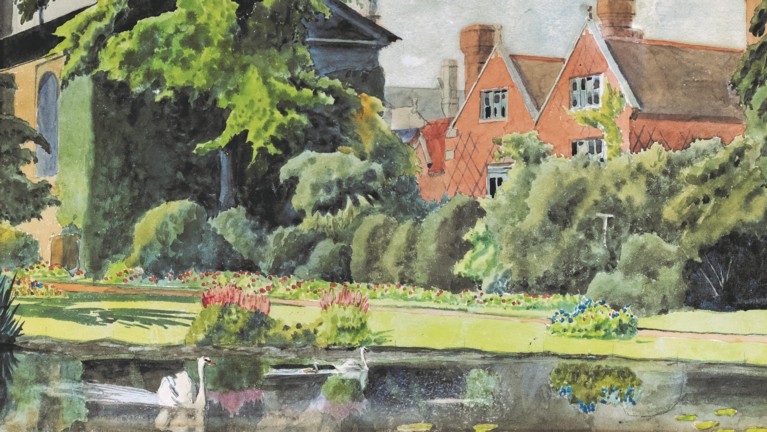Blog
19 January 2023

Swans on the Paddock pond, with the Chapel and old Master's Lodge in the background
Thomas Young was, according to his epitaph in Westminster Abbey, ‘a man alike eminent in almost every department of human learning’. It is therefore fitting that the new court at Emmanuel is to bear his name. Young was admitted here in March 1797, ostensibly to study for the M.B., but as he was already a qualified physician he spent his time reading widely and conducting scientific experiments. Some years ago, the late Dr Frank Stubbings, college Fellow and librarian, noted that ‘an attractive tradition has it that [Young] first observed the phenomenon of ‘interference’ in the ripples set up by two swans on the Emmanuel pond. This phenomenon…was important to his arguments for a wave theory of light’. The origin of this ‘tradition’ is obscure; the earliest allusion to it in the college archives seems to be an entry in a student society’s minute book.
In 1929 the college’s Natural Science Club changed its name to the ‘Thomas Young Club’, and proposed that members should have a distinctive new tie. After considering various patterns, it was decided in February 1930 to adopt ‘the original design with swans’. Photographic evidence shows that this tie had a repeating motif of two diagonal parallel lines containing a row of swans. The lines were an allusion to Young’s famous ‘double slits’ experiment, and the swans, clearly, referred to Young’s supposed observations of ‘interference’ on the Paddock pond. By the mid-1940s the design had been modified, with the swans now being much more widely spaced. Perhaps they had been too reminiscent of a row of target ducks in a fairground booth!
(1).jpg)
Thomas Young Club tie, donated by Donald Maxwell (1944)
Clearly, an oral tradition about Young’s swans had existed for some time before 1930, but did it derive from anything other than mere whimsy? One element of the story is certainly dubious, for there is no evidence that Emmanuel had any resident swans until well after Young had gone down. Presumably, though, ducks or moorhens could have produced the same ripple effects. It is also indisputable that Young himself never directly mentioned either of our ponds, or the swimming bath, in any of his writings. The college archives are equally silent; the Parlour wager books, for instance, contain no obliging references to any watery experiments carried out by Young during his three years’ residence.
It seems likely that it was the following famous passage in a pamphlet Young published in 1804 that (probably much later) gave rise to the ‘swans’ tradition: ‘Suppose a number of equal waves of water to move upon the surface of a stagnant lake, with a constant velocity, and to enter a narrow channel leading out of the lake. Suppose then, another similar cause to have excited another equal series of waves, which arrive at the same channel, with the same velocity, and at the same time with the first…Now I maintain that similar effects take place wherever two portions of light are thus mixed, and this I call the general law of the interference of light’.
This description of a still lake with a narrow outfall does sound very much like the Paddock pond, and it is certainly tempting to imagine that Young had it mind when developing his theory. True, he declared, in the same 1804 pamphlet, that it was not until ‘May 1801’ (that is, a year after he went down) that the full revelation of the ‘law’ of interference came to him in a moment of inspiration, but it is possible that he was subconsciously remembering the Emmanuel wildfowl. Whether fact or fiction, however, the ‘swans’ tradition is a charming story.
Amanda Goode, College Archivist
